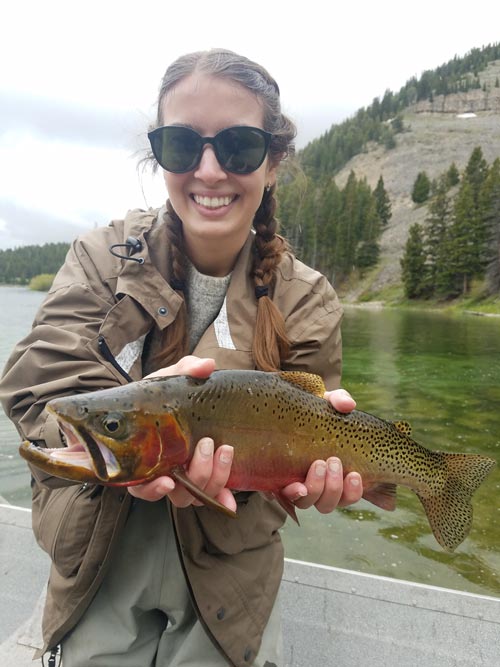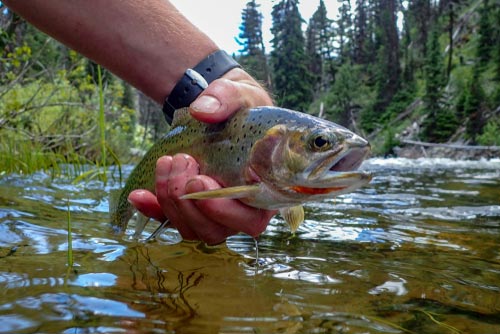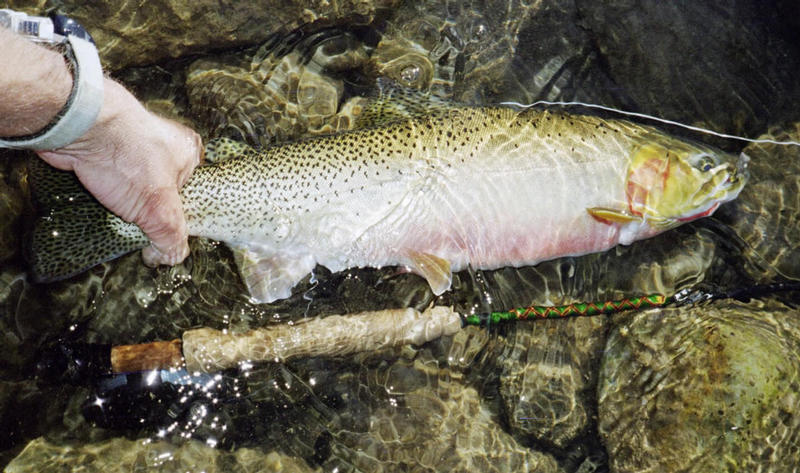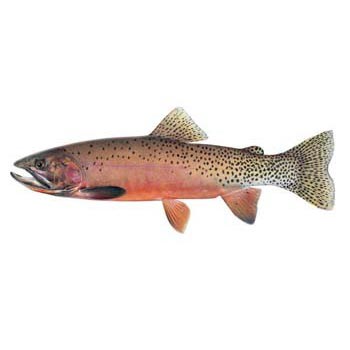




The westslope cutthroat trout is one of two subspecies of native cutthroat found in the state alongside Yellowstone cutthroat trout. Together they have been designated Montana's state fish.
Cutthroat trout are so named for the red slashes near the lower jaws. The westslope cutthroat trout's historical range was all of Montana west of the Continental Divide as well as the upper Missouri River drainage. This fish has been seriously reduced in its range by two primary factors: hybridization with Rainbow and/or Yellowstone cutthroat trout, and habitat loss and degradation.
Since the westslope is recognized as a very important part of our native fish fauna it has been designated a Fish of Special Concern in Montana. Pure westslope cutthroat trout have been identified by genetic analysis and form the broodstock maintained by the FWP at its Anaconda hatchery.
Some of the documents posted are in draft form. However, they are being used to guide westslope cutthroat trout conservation efforts in Montana pending their finalization.
Click here to learn more about the distribution of westslope cutthroat trout in Montana.
Click here to read the fishing regulations in Montana.
The South Fork Flathead River within the Bob Marshall Wilderness in northwest Montana has the largest genetically pure population in the world. The South Fork drainage contains 355 lakes and approximately 1,898 miles of stream habitat. This drainage was isolated from the mainstem Flathead River by the construction of Hungry Horse Dam in 1952. The reservoir and the remaining South Fork river maintain a unique assemblage of native fish such as bull trout, mountain whitefish, pygmy whitefish, westslope cutthroat trout and suckers.
Within Montana, the South Fork watershed comprises more than half of the remaining interconnected populations of genetically pure westslope cutthroat trout, a species that has declined to less than 10% of its historic range due to habitat degradation, and hybridization and competition with introduced fishes. Yet, even within this cutthroat trout stronghold, historic stocking of headwater lakes and the downstream movement of nonnative rainbow and Yellowstone cutthroat trout has led to the spread of hybridization and the gradual loss of locally adapted gene pools in native westslope cutthroat populations.
To protect the legacy of this native trout and the fishery it supports, biologists with Montana Fish, Wildlife, and Parks and the US Forest Service implemented a landscape scale conservation strategy to preserve westslope cutthroat in the South Fork Flathead watershed. The goal of this effort was to remove the sources of nonnative trout from 21 headwater lakes where hybridization is occurring and reestablish native westslope cutthroat trout populations.
To achieve this goal, biologists used the piscicide rotenone to eradicate the current fishery in order to restock it with native cutthroat. The first two lakes associated with this project were treated with rotenone during the fall of 2007. The remaining lakes were treated at a rate of one or two per year ending with Sunburst Lake in 2017. All of the treated lakes were restocked with pure westslope cutthroat trout.
Black Lake is a 49 acre lake located in the Jewel Basin Hiking Area at the headwaters of Graves Creek. The lake and its outlet stream were treated with rotenone on September 27, 2007. The rotenone was applied by SEAT (single engine air tanker), small boat, and streamside drip stations. The lake was stocked with westslope cutthroat trout in the early spring of 2008.
Blackfoot Lake is a 16 acre lake located in the Jewel Basin Hiking Area. It has a maximum depth of 22’ and supported one of the highest levels of rainbow trout hybridization in the South Fork Flathead drainage. On October 8, 2007 Blackfoot Lake and its associated inlet and outlet creeks were treated with rotenone to remove all fish from this system. The lake was stocked with westslope cutthroat trout in 2008. Adult fish were observed spawning in the creeks in 2009.
Big Hawk Lake is located at the southern edge of the Jewel Basin Hiking Area on the Flathead National Forest. The lake, the outlet, two inlet creeks, and Jones Creek down to a barrier falls at Forest Road 1607 were treated with rotenone on September 25, 2008. Potassium permanganate was used to neutralize treated water before it reached Aeneas Creek. The lake was restocked with westslope cutthroat trout in early spring 2009.
Clayton Lake is located in the Jewel Basin Hiking Area at the headwaters of Clayton Creek. The lake and creek were treated with rotenone on September 22, 2009 to remove hybrid trout from the lake and downstream 4.5 miles of Clayton Creek to a barrier waterfall downstream of Forest Road 895. Potassium permanganate was used to neutralize treated water before it reached Hungry Horse Reservoir. Prior to treatment, possession limits were lifted from the lake allowing anglers increased harvest opportunities. The lake was restocked with westslope cutthroat trout in 2010.
Margaret Lake is situated at the headwaters of Forest Creek on the Flathead National Forest. This lake was treated with rotenone on September 10, 2009. Sentinel fish were placed in Forest Creek to monitor natural detoxification. This method was successful and potassium permanganate was not used. The lake was restocked in spring 2010.
Wildcat Lake is located near the northern boundary of the Jewel Basin Hiking Area on the Flathead National Forest. Wildcat Lake was treated with rotenone on September 30, 2010. Lower Wildcat Lake and Wildcat Creek were treated September 14, 2010. Potassium permanganate was used to neutralize the treated water before it entered Wounded Buck Creek. Wildcat Lake was stocked with westslope cutthroat trout in 2011.
Necklace Chain of Lakes and Smoky Creek were treated with rotenone on August 31- September 1, 2011. The treatment included all of Smoky Creek and its connected lakes beginning at the outlet of Necklace Lake #1 and ending at the confluence of Smoky Creek and Big Salmon Creek. Potassium permanganate was used to neutralize the treated water in Smoky Creek before it entered Big Salmon Creek. The two largest lakes in the chain, Lakes 5 and 8, were restocked with westslope cutthroat trout in 2012.
On September 10, 2012 Lick Lake and the outlet creek were treated with rotenone down to the confluence with Doctor Creek. Potassium permanganate was used to neutralize the treated water at the Gordon/Doctor Creek confluence. Lick Lake was restocked in 2013 with westslope cutthroat trout.
The upper Big Salmon Creek drainage was treated with rotenone between September 6th and 8th, 2013. This treatment included Feline Creek, Pendant Creek, Lena Lake, and Big Salmon Creek from Lena Lake down to the upper Big Salmon Creek falls in T20N R15W Section 4. Lena Lake, Big Salmon Creek and Pendant Creek were restocked in 2014 with westslope cutthroat trout.
Koessler Lake, its inlet and outlet creeks, and Doctor Creek were treated with rotenone on September 8, 2014. Potassium permanganate was used to neutralize treated water in Doctor Creek before it entered Gordon Creek. Koessler Lake was restocked with westslope cutthroat trout in 2015.
A portion of the Big Salmon Creek drainage was treated with rotenone September 22-23, 2015. The treatment began at upper Big Salmon Creek falls (T20N, R15W, S4) and included all of Cataract Creek, 300 meters of Dart Creek, Albino Creek beginning in the southwest corner of Section 21, and Tango Creek beginning near the Section 28/29 boundary and continuing to the Big Salmon Creek confluence. Potassium permanganate was used to neutralize treated water at the confluence of Tango Creek and Big Salmon Creek.
Handkerchief Lake is located on the Flathead National Forest on the west side of Hungry Horse Reservoir. It is a 51-acre lake with a maximum depth of 24’. Graves Creek flows out of Handkerchief Lake for 0.5 mile before it joins Aeneas Creek, then flows another 0.8 mile before reaching a waterfall just above Hungry Horse Reservoir. Handkerchief Lake and portions of Graves Creek were treated with rotenone on September 13, 2016 to remove the existing fishery of hybridized rainbow/cutthroat trout and arctic grayling. Potassium permanganate was used to neutralize the treated water in Graves Creek before it entered Hungry Horse Reservoir. Genetically pure strains of westslope cutthroat trout and Red Rocks arctic grayling will be stocked into the lake beginning in 2017.
Sunburst Lake is one of the largest lakes in the South Fork Flathead River drainage with a volume of 12,407 acre-ft, 149 surface acres, and a max depth of 204’. Sunburst Lake was treated with the piscicide rotenone on September 4-5, 2017 to remove the existing hybridized trout fishery. Genetically pure strains of native westslope cutthroat trout will be stocked into the lake beginning in 2018.
Biologists use a variety of tools to manage and conserve Montana's fishery resources. Fish stocking is one such tool that can be used to enhance fishing opportunity and help conserve populations of native fish. While stocking is most commonly used to supplement fisheries in lakes with little or no natural reproduction, in some situations it is used to replace or "swamp out" introduced fish with the native fish species.
Beginning in the 1920s and '30s many alpine lakes in the South Fork Flathead drainage were planted with nonnative rainbow and/or Yellowstone cutthroat trout. Although these lakes are located above barrier waterfalls and were historically fishless, they contain quality trout habitat and the stocking was successful in establishing trout populations. After the creation of Montana Fish, Wildlife & Parks westslope cutthroat trout broodstock in the mid-1980s, these lakes were stocked exclusively with native fish from this brood source. Frequent stocking (i.e. swamping) and successful reproduction of westslope cutthroat trout changed the genetic characteristics of fish in these lakes and, in some cases, resulted in populations predominantly comprised of genetically pure westslope cutthroat trout.
As a result, MFWP resumed swamping in Pyramid, George, Woodward, and Pilgrim lakes in 2009 and Upper and Lower Three Eagles lakes in 2010. Periodic genetic sampling will be used to evaluate the success of this technique as an alternative method to piscicide treatment for replacing nonnative trout with westslope cutthroat trout.
About Rotenone (PDF)
In May 2006, Montana Fish, Wildlife & Parks, along with Bonneville Power Administration and the Forest Service, issued their Records of Decision for the Environmental Impact Statement for the South Fork Flathead Westslope Cutthroat Trout Conservation Program. The purpose of this program is to protect the genetic purity of westslope cutthroat trout in the South Fork Flathead by removing hybrid trout from headwater lakes and restocking with genetically pure westslope cutthroat trout. To address the issue, the three agencies prepared an EIS that considered and analyzed three action alternatives (which included one preferred alternative), and a fourth "No Action" alternative;
Alternative A: No Action - status quo management
Alternative B: Proposed action - use the piscicides antimycin and rotenone with combined (livestock and motorized) transport and application methods
Alternative C: Fish toxins -use motorized/mechanized transport and application methods
Alternative D: Suppression techniques and genetic swamping.
Montana Fish, Wildlife & Parks has made a decision to implement Alternative B (proposed action) as described in the Record of Decision and the EIS.
Supplemental Information Report - Lena and Koessler Lakes — April 15, 2013 (PDF)
FWP Record of Decision (ROD) News Release — April 2006 (PDF)
Forest Service ROD (PDF)
Final Environmental Impact Statement (EIS) — July 2005 (PDF)
Final EIS Responses to Comments 1-40 — July 2005 (PDF)
